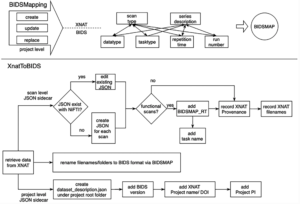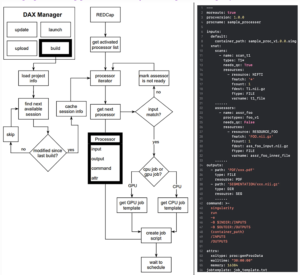Integrating the BIDS Neuroimaging Data Format and Workflow Optimization for Large-Scale Medical Image Analysis
Shunxing Bao, Brian D Boyd, Praitayini Kanakaraj, Karthik Ramadass, Francisco A. C. Meyer, Yuqian Liu, William E. Duett, Yuankai Huo, Ilwoo Lyu, David H. Zald, Seth A. Smith, Baxter P. Rogers, Bennett A. Landman. Integrating the BIDS Neuroimaging Data Format and Workflow Optimization for Large-Scale Medical Image Analysis. J Digit Imaging (2022). https://doi.org/10.1007/s10278-022-00679-8
Abstract
A robust medical image computing infrastructure must host massive multimodal archives, perform extensive analysis pipelines, and execute scalable job management. An emerging data format standard, the Brain Imaging Data Structure (BIDS), introduces complexities for interfacing with XNAT archives. Moreover, workflow integration is combinatorically problematic when matching large amount of processing to large datasets. Historically, workflow engines have been focused on refining workflows themselves instead of actual job generation. However, such an approach is incompatible with data centric architecture that hosts heterogeneous medical image computing. Distributed automation for XNAT toolkit (DAX) provides large-scale image storage and analysis pipelines with an optimized job management tool. Herein, we describe developments for DAX that allows for integration of XNAT and BIDS standards. We also improve DAX’s efficiencies of diverse containerized workflows in a high-performance computing (HPC) environment. Briefly, we integrate YAML configuration processor scripts to abstract workflow data inputs, data outputs, commands, and job attributes. Finally, we propose an online database–driven mechanism for DAX to efficiently identify the most recent updated sessions, thereby improving job building efficiency on large projects. We refer the proposed overall DAX development in this work as DAX-1 (DAX version 1). To validate the effectiveness of the new features, we verified (1) the efficiency of converting XNAT data to BIDS format and the correctness of the conversion using a collection of BIDS standard containerized neuroimaging workflows, (2) how YAML-based processor simplified configuration setup via a sequence of application pipelines, and (3) the productivity of DAX-1 on generating actual HPC processing jobs compared with earlier DAX baseline method. The empirical results show that (1) DAX-1 converting XNAT data to BIDS has similar speed as accessing XNAT data only; (2) YAML can integrate to the DAX-1 with shallow learning curve for users, and (3) DAX-1 reduced the job/assessor generation latency by finding recent modified sessions. Herein, we present approaches for efficiently integrating XNAT and modern image formats with a scalable workflow engine for the large-scale dataset access and processing.

Two components of BIDS download tool. The BIDSMapping tool allows the user to create, update, or replace rules/mapping at the project level on XNAT. XnatToBids function uses the mapping at the project to transform XNAT data into the BIDS compliant data with BIDS filenames and folder structure.

We highlight the optimizing DAX Manager on build module. The centric optimization is using YAML configuration processor scripts (a sample processor is presented on the right) to abstract processors’ inputs and outputs. The YAML configuration file implement mapping inputs and outputs to singularity-based application. Finally, the HPC computation resource (walltime, memory) and job type (CPU or GPU based) are also defined in the same YAML scripts for each processor.